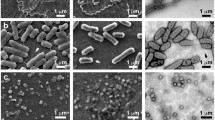Summary
Characteristic particles of hog cholera virus were identified by direct immuno-electron microscopy. The virion is 40–50mμ, often asymmetrically shaped, and is enveloped in a membrane that bears 12–15 mμ surface projections. The surface projections are shear-sensitive and are antigenically different from the virion's envelope. They may represent hog cholera virus “soluble antigen”.
Similar content being viewed by others
References
Bachrach, H. L.: Physico- and immunochemical studies of the hog cholera virus. Ph. D. Thesis, University of Minnesota, St. Paul, Minnesota, U.S.A. (1949).
Baker, J. A.: Serial passage of hog cholera virus in rabbits. Proc. Soc. exp. Biol. (N.Y.)63, 183–187 (1946).
Bodon, L.: Occurrence of contaminant viruses in various hog cholera virus strains. I. Adenoviruses. Acta vet. Acad. Sci. hung.16, 321–327 (1966).
Boynton, W. H.: Preliminary report on the propagation of hog cholera virus. Vet. Med.41, 346–347 (1946).
Boynton, W. H., W. N. Takahashi, G. M. Woods, andW. W. Walker: Further studies on propagation of hog cholera virus in vitro including electron micrographs. Vet. Med.43, 403–406 (1948).
Brenner, S., andR. W. Horne: A negative staining method for high resolution electron microscopy of viruses. Biochim. biophys. Acta (Amst.)34, 103–110 (1959).
Cunliffe, H. R.: The purification and concentration of hog cholera virus. M. S. Thesis, Iowa State University, Ames, Iowa, U.S.A. (1967).
Darbyshire, J. H.: A serological relationship between swine fever and mucosal disease of cattle. Vet. Rec.72, 331 (1960).
Gillespie, J. H., B. E. Sheffy, andJ. A. Baker: Propagation of hog cholera virus in tissue culture. Proc. Soc. exp. Biol. (N.Y.)105, 679–681 (1960).
Hanig, M.: Hog cholera virus: immunochemical studies. Ph. D. Thesis, University of Minnesota, St. Paul, Minnesota, U.S.A. (1946).
Hecke, F.: Die künstliche Vermehrung des Schweinepestvirus mittels Gewehekulturen. Zbl. Bakt. I. Abt. Orig.126, 517–526 (1932).
Horne, R. W., andA. P. Waterson: A helical structure in mumps, Newcastle disease and Sendai viruses. J. molec. Biol.2, 75–77 (1960).
Horne, R. W., A. P. Waterson, P. Wildy, andA. E. Farnham: The structure and composition of the myxoviruses. I. Electron microscope studies of the structure of myxovirus particles by negative staining techniques. Virology11, 79–98 (1960).
Horzinek, M.: Characterization of hog cholera virus. I. Determination of buoyant density. J. Bact.92, 1723–1726 (1966).
Horzinek, M., M. Mussgay, J. Maess, andK. Petzoldt: Nachweis dreier Virusarten (Schweinepest-, Adeno-, Picodnavirus) in einem als cytopathogen bezeichneten Schweinepest-Virusstamm. Arch. ges. Virus-forsch.21, 98–112 (1967).
Horzinek, M., andS. Überschär: Charakterisierung eines Schweine-Adenovirus im Zusammenhang mit Untersuchungen über das Virus der europäischen Schweinepest. Arch. ges. Virusforsch.18, 406–421 (1966).
Kernkamp, H. C. H.: Some of the physico-chemical properties of the virus of hog cholera. J. Amer. vet. med. Ass.74, 844–862 (1929).
Koprowski, H., T. R. James, andH. R. Cox: Propagation of hog cholera virus in rabbits. Proc. Soc. exp. Biol. (N.T.)63, 178–183 (1946).
Kumagai, T., T. Shimizu, S. Ikeda, andM. Matumoto: A newin vitro method (END) for detection and measurement of hog cholera virus and its antibody by means of effect of HC virus on Newcastle disease virus in swine tissue culture. I. Establishment of standard procedure. J. Immunol.87, 245–256 (1961).
Lee, R. C. T.: An electron microscopic study of the cytopathogenic changes in cells infected with hog cholera virus and grown in vitro. Cornell Vet.52, 39–51 (1962).
Mahnel, E.: Report of the FAO/OIE Intern. Meet. on Hog Cholera and African Swine Fever, May 31 to June 5, in Rome, Abst. No. 17 (1965).
Malmquist, W. A., A. L. Fernelius, andD. E. Gutekunst: Interference of bovine viral diarrhea virus by hog cholera virus in swine kidney cell cultures. Amer. J. vet. Res.26, 1316–1327 (1965).
Mayr, A., P. A. Bachmann, B. E. Sheffy, andG. Siegl: Electron optical and buoyant density studies of hog cholera virus. Arch. ges. Virusforsch.21, 113–119 (1967).
Mayr, A., andH. Mahnel: Weitere Untersuchungen über die Züchtung von Schweinepestvirus in Zellkulturen mit cytopathogenem Effekt. Zbl. Bakt. I. Abt. Orig.199, 399–407 (1966).
Pehl, K. H., andH. Gralheer: Untersuchungen zur Größenbestimmung des Schweinepestvirus durch Ultrafiltration. Arch. exp. Vet.-Med.10, 699–701 (1956).
Reagan, R. L., A. L. Brueckner, andL. J. Poelma: Morphologic studies of hog cholera virus by electron microscopy. Amer. J. vet. Res.12, 116–117 (1951).
Ritchie, A. E., andA. L. Fernelius: Electron microscopy of hog cholera virus and its antigen-antibody complex. Vet. Rec.81, 417–418 (1967).
Schulze, P.: Elektronenmikroskopische Untersuchungen zum Nachweis des Schweinepestvirus in Endothelzellen. Arch. exp. Vet.-Med.20, 1349–1352 (1966).
Solorzano, B. F.: Anin vitro test for hog cholera. Ph. D. Thesis, The Pennsylvania State University, University Park, Pennsylvania, U.S.A. (1962).
Stair, E. L., M. B. Rhodes, J. M. Aiken, N. R. Underdahl, andG. A. Young: A hog cholera virus-fluorescent antibody system. Its potential use in study of embryonic infection. Proc. Soc. exp. Biol. (N.Y.)113, 656–660 (1963).
TenBroeck, C.: Cultivation of the hog cholera virus. J. exp. Med.74, 427–432 (1941).
Author information
Authors and Affiliations
Rights and permissions
About this article
Cite this article
Ritchie, A.E., Fernelius, A.L. Direct immuno-electron microscopy and some morphological features of hog cholera virus. Archiv f Virusforschung 23, 292–298 (1968). https://doi.org/10.1007/BF01241903
Received:
Issue Date:
DOI: https://doi.org/10.1007/BF01241903




